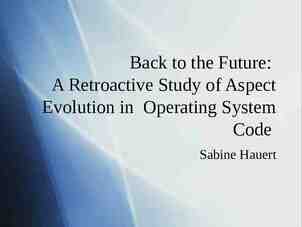Chapter 14: Well-Performance Tests Analysis and Evaluation of Pumping
24 Slides780.95 KB
Chapter 14: Well-Performance Tests Analysis and Evaluation of Pumping Test Data Revised Second Edition Kruseman & de Ridder
Introduction A well-performance test is conducted to determine aquifer losses and well losses. Aquifer losses are the head losses that occur in the aquifer where the flow is laminar. Well losses are divided into linear and non-linear head losses. - Linear well losses are caused by damaging of the aquifer during and completion of the well. - Non-linear well losses are the friction losses that occur inside the well screen and in the suction pipe where the flow is turbulent. drilling “Skin effect” concept of head losses in vicinity of well due to varying hydraulic conductivities.
Head Losses in a Pumped Well
Step-Drawdown Test A single-well test process consisting of pumping the well at increasing constant discharge rates (Q) until the drawdown becomes stable at each Q. This process is repeated through at least three steps of equal duration. Jacob equation: It is not possible to determine rew from the data of a step-drawdown test because you must know the storativity of the aquifer, which can only be obtained from piezometer observations.
Variation to Jacob’s Equation Other researchers have suggested variations to Jacob’s equation based on differences found between the flows inside and outside the well. The value of P 2 is widely accepted. We can predict the drawdown inside the well for any realistic discharge (Q) at a certain time (t), then Find the relationship between drawdown and discharge to choose an optimum yield for the well or to evaluate the well’s efficiency and/or condition.
Well Efficiency The specific capacity of a well (Q/sw ) describes the productivity of the aquifer and the well. - decreases as pumping continues - decreases as discharge increases Well effiency (Ew ): However, the true degree of a well’s imperfections cannot be determined due to the difficulty of separating linear aquifer-losses and linear well-losses.
Total Drawdown Inside a Well due to Well Losses The concepts of linear and non-linear head loss components relate to the concepts of skin effect and non-Darcy, turbulent flow. The total drawdown inside a well due to well losses can be expressed as:
Hantush-Bierschenk’s Method To determine values of B and C (aquifer losses and linear and non-linear well losses). Hantush expresses the drawdown sw(n) in a well during the n-th step of a stepdrawdown test as:
Hantush-Bierschenk’s Method (cont’d) After summing the increments of drawdown taken at a fixed interval of time from the beginning of each step, we can write the equation as follows: This method can only be applied when: the assumptions listed at the beginning of Chapter 3 except the 1st and 5th are met the aquifer is confined, leaky, or unconfined the aquifer is pumped step-wise at increased discharge rates the flow to the well is in an unsteady state the non-linear well losses are appreciable.
Hantush-Bierschenk’s Method (cont’d) Determination of the drawdown difference for each step:
Hantush-Bierschenk’s Method (cont’d) Determination of parameters B and C (aquifer losses and well losses):
Eden-Hazel’s Method From step-drawdown tests in a fully penetrating well that taps a confined aquifer, this method can determine the well losses and transmissivity of the aquifer. The drawdown in the well is given by the Jacob equation:
Eden-Hazel’s Method (cont’d) We can derive the drawdown at time t during the n-th step from: This equation accounts for the influence of non-linear well losses:
Eden-Hazel’s Method (cont’d) The Eden-Hazel procedure can be used if: all the assumptions at the beginning of chapter 3 except for the 5th are met the aquifer is pumped step-wise at increased discharge rates the flow to the well is in an unsteady state u (r2S/4KDt) 0.01 the non-linear well losses are appreciable
Eden-Hazel’s Method (cont’d) Plot of s(w)n (drawdown at time t) versus Hn (discharge increment at time t)
Rorabaugh’s Method Gives values of B (linear aquifer losses and linear well losses), C (non-linear well losses), and P (discharge coefficient). This method can be applied when: all the assumptions listed at the beginning of chapter 3 except for the 1st and 5th are met the aquifer is confined, leaky, or unconfined the aquifer is pumped step-wise at increased discharge rates the flow to the well is in an unsteady state the non-linear well losses are appreciable.
Rorabaugh’s Method (cont’d) A plot of drawdown at time t minus linear losses versus constant discharge during the n-th step: (trial-and-error straight line method)
Sheahan’s Method It gives values of B (linear aquifer losses and linear well losses), C (non-linear well losses), and P (discharge coefficient). Assuming that B 1, C 1, P 1, and that Qi is given for all values of P, we can calculate the ratio s(w)n/Qn for selected values of Qn and P using the equation from the Rorabaugh method. This method can be applied when: All the assumptions listed at the beginning of chapter 3 except for the 1st and 5th are met The aquifer is confined, leaky, or unconfined The aquifer is pumped step-wise at increased discharge rates The flow to the well is in an unsteady state The non-linear well losses are appreciable
Sheahan’s Method (cont’d) The values can be plotted as a family of type curves:
Sheahan’s Method (cont’d) When we plot drawdown-discharge (s(w)n/Qn and Qn) data, we find that the best match with Sheahan’s type curves is with the curve for P 2.8, as seen in this plot:
Determination of the Skin Factor The skin effect is defined as the difference between the total drawdown observed in a well and the aquifer loss component, assuming the non-linear well losses are negligible. If the effective radius of the well rew is larger than the real radius of the bore hole rw, it is a positive skin effect. If rew rw, the well is usually poorly developed or its screen is clogged, and it’s a negative skin effect. The procedure for determining the skin factor is applicable under these conditions: All the assumptions listed at the beginning of chapter 3 are adjusted for recovery tests The aquifer is confined, leaky, or unconfined The flow to the well is in an unsteady state u 0.01 u’ 0.01 The linear well losses (the skin effect) are appreciable and the non-linear well losses are negligible.
Determination of the Skin Factor (cont’d) Adding the skin effect to Jacob’s equation, we obtain the following equation for the drawdown in a well that fully penetrates a confined aquifer and is pumped at a constant rate:
Determination of the Skin Factor (cont’d) After the pump has been shut down, we measure the residual drawdown s’w in the well with:
AQTESOLV Step-drawdown test in a confined aquifer, Saudi Arabia - Uses Theis step-drawdown solution





























